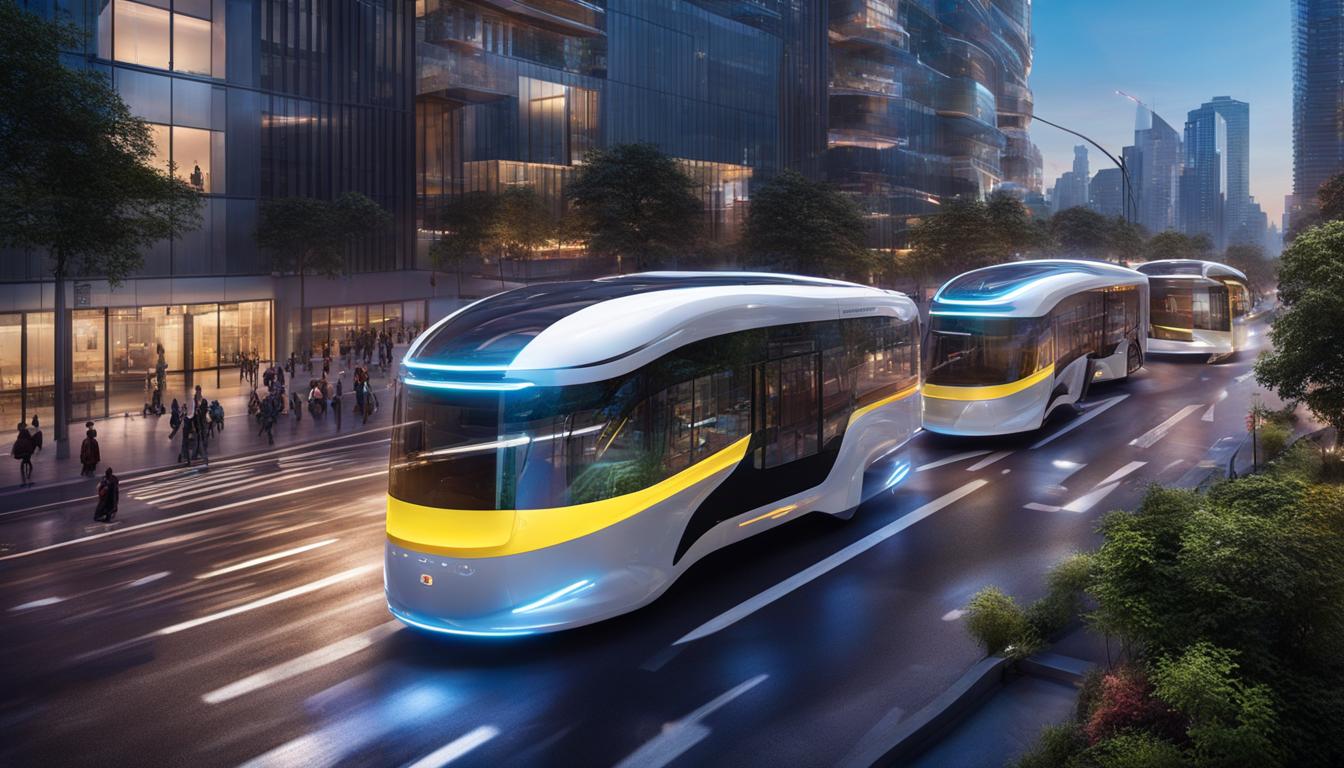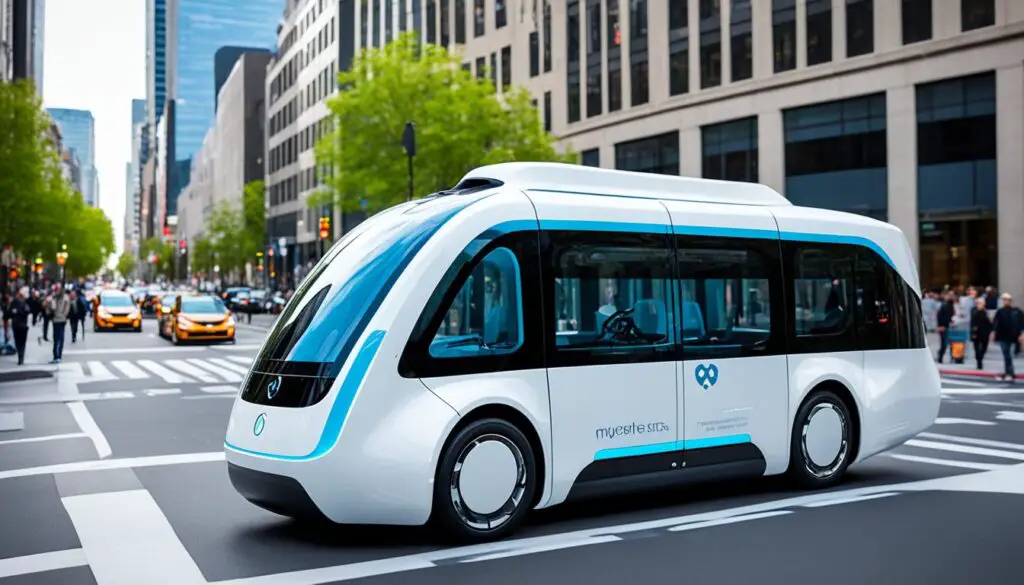
On the Horizon: Autonomous Public Transportation Systems
I am excited to explore the future of mobility in urban travel as we discuss the topic of autonomous public transportation. The world of transportation is on the brink of a revolution, with advancements in technology paving the way for a new era of efficient and sustainable travel.
Autonomous vehicles, also known as self-driving cars, are set to change the way we commute in cities across the United States. These vehicles have the potential to transform the way we experience transportation by revolutionizing the traditional modes of travel. The future of mobility is here, and it is autonomous.
From reducing congestion to improving safety, autonomous public transportation systems have the power to address the challenges faced by urban areas. By leveraging cutting-edge technology, these systems can optimize routes, minimize travel times, and provide a convenient and accessible mode of transportation for all.
Key Takeaways:
- Autonomous public transportation systems are set to revolutionize urban travel in the United States.
- These systems have the potential to improve efficiency, reduce congestion, and enhance safety.
- Challenges such as regulations and infrastructure need to be addressed for successful implementation.
- The future of autonomous public transportation holds great promise for sustainable and resilient cities.
- Continued investment in research and development is crucial to unlock the full potential of autonomous technology.
Advantages of Autonomous Public Transportation Systems
Implementing autonomous public transportation systems offers several significant advantages. Firstly, these systems have the potential to greatly improve the efficiency of transportation networks.
By optimizing routes and reducing congestion, autonomous vehicles can streamline traffic flow and decrease travel times. This enhanced efficiency results in a smoother transportation experience for passengers and contributes to a more sustainable and environmentally friendly mode of transportation.
The safety benefits of autonomous vehicles are also notable. With advanced collision avoidance systems and real-time data analysis, these vehicles are designed to minimize the risk of accidents and improve overall road safety. The use of autonomous public transportation systems can help reduce the number of accidents caused by human error, leading to safer roads for everyone.
Furthermore, autonomous public transportation can provide a convenient and accessible mode of transportation for individuals who do not own private vehicles. This has the potential to greatly improve mobility and accessibility, particularly for underserved communities. Autonomous vehicles have the ability to bridge the gap between different neighborhoods, making it easier for people to access essential services, education, and employment opportunities.
Autonomous public transportation systems bring efficiency, safety, and accessibility advantages, improving urban mobility for all.
These advantages of implementing autonomous public transportation systems contribute to a more efficient, safe, and accessible transportation network. By leveraging the capabilities of autonomous vehicles, cities can optimize their public transportation systems to better serve their residents and reduce congestion on the roads.
Now, let’s take a closer look at the advantages of implementing autonomous public transportation systems with this comprehensive table:
| Advantages | Description |
|---|---|
| Improved Efficiency | Optimized routes and reduced congestion |
| Enhanced Safety | Advanced collision avoidance systems and real-time data analysis |
| Increased Accessibility | Convenient and accessible transportation for underserved communities |

As seen from the table and the accompanying image, the advantages of autonomous public transportation systems are clear. These systems have the potential to revolutionize urban mobility and pave the way for a more efficient, safe, and inclusive transportation future.
Challenges and Considerations for Autonomous Public Transportation
While the implementation of autonomous public transportation systems brings numerous benefits, there are also several challenges and considerations that need to be addressed. One of the key challenges is the development of robust regulations and policies to govern the operation of autonomous vehicles. This includes issues related to liability, data privacy, and cybersecurity.
Ensuring the safety of passengers and pedestrians is of utmost importance when it comes to autonomous public transportation. The regulations need to establish standards for the performance and behavior of autonomous vehicles, including their ability to detect and respond to unforeseen situations on the road. Additionally, liability frameworks must be established to determine responsibility in the event of accidents or malfunctions.
Data privacy and cybersecurity are also crucial considerations. Autonomous vehicles generate vast amounts of data, including real-time location information and personal data of passengers. It is essential to establish regulations that protect the privacy and secure the data collected by these vehicles. Moreover, robust cybersecurity measures need to be in place to prevent unauthorized access and potential threats to the autonomous transportation system.
Another important consideration is the existing infrastructure. The deployment of autonomous vehicles may require significant upgrades or modifications to the current transportation infrastructure. For example, the installation of smart sensors and communication systems may be necessary to ensure the seamless operation of autonomous public transportation. Adequate charging or refueling infrastructure for electric or hydrogen-powered autonomous vehicles should also be in place to support their widespread adoption.
Public acceptance and trust in autonomous technology play a vital role in the successful implementation of autonomous public transportation systems. Education and awareness programs can help address concerns and build confidence among the public. Additionally, involving stakeholders such as transportation authorities, city planners, and community leaders in the decision-making process can foster a sense of ownership and involvement, leading to greater acceptance of autonomous public transportation.
Key Considerations:
- Development of robust regulations and policies
- Ensuring safety, liability, and accountability
- Data privacy and cybersecurity
- Upgrading infrastructure
- Building public acceptance and trust
Addressing these challenges and considerations is crucial for the successful adoption and integration of autonomous public transportation systems. By balancing regulatory frameworks, infrastructure upgrades, and public acceptance, we can unlock the full potential of autonomous technology in revolutionizing urban mobility.

Conclusion
Autonomous public transportation systems are poised to revolutionize urban travel in the United States. With their ability to improve efficiency, enhance safety, and provide convenient access to transportation, these autonomous vehicles have the potential to address the challenges of urban mobility and contribute to building sustainable and resilient cities. However, the successful implementation of these systems requires careful planning, collaboration, and the development of supportive policies and infrastructure.
Looking ahead, it is crucial to continue investing in research and development to further advance autonomous technology and unlock its full potential in transforming the way we travel. By harnessing the power of autonomous public transportation, we can create a future where urban travel is more efficient, safer, and more accessible for all.
The future of mobility lies in the integration of autonomous public transportation into our transportation networks. As we embrace this transformative technology, we have the opportunity to shape the future of urban travel and build a more sustainable and connected society. It is an exciting time for innovation and progress in the transportation industry, and autonomous public transportation is at the forefront of this movement.
FAQ
What is autonomous public transportation?
Autonomous public transportation refers to the use of self-driving vehicles in the public transportation system. These vehicles operate without the need for human drivers and rely on advanced technologies to navigate and transport passengers.
How can autonomous public transportation improve efficiency?
Autonomous public transportation systems can improve efficiency by optimizing routes, reducing congestion, and streamlining the flow of traffic. This can result in reduced travel times for passengers and a smoother overall transportation network.
What are the safety benefits of autonomous public transportation?
Autonomous public transportation vehicles are equipped with advanced collision avoidance systems and real-time data analysis, which can help minimize the risk of accidents and improve road safety. These vehicles have the potential to significantly reduce human error-related incidents.
Can autonomous public transportation benefit underserved communities?
Yes, autonomous public transportation can provide a convenient and accessible mode of transportation for individuals who do not own private vehicles. This can improve mobility and accessibility, particularly for underserved communities that may have limited transportation options.
What are the regulatory challenges associated with autonomous public transportation?
The development of robust regulations and policies is crucial to govern the operation of autonomous public transportation systems. This includes addressing issues related to liability, data privacy, and cybersecurity to ensure the safe and secure operation of these vehicles.
What infrastructure modifications are required for autonomous public transportation?
The existing infrastructure may need to be upgraded or modified to support the deployment of autonomous vehicles. This can involve the installation of smart sensors and communication systems to facilitate the interaction between autonomous vehicles and the transportation network.
How can public acceptance and trust be built for autonomous technology?
Public acceptance and trust in autonomous technology are crucial for the successful adoption of autonomous public transportation systems. Education and awareness programs can help address concerns and build confidence among the public by highlighting the safety measures and benefits of autonomous vehicles.
